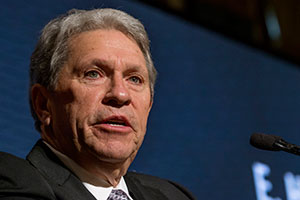CP’s Quest for Norfolk Southern Intensifies

MIAMI — Canadian Pacific Railway Ltd. and Norfolk Southern Corp. have upped the stakes in a $30 billion battle for control of the U.S. railway, as the potential acquirer said it would take its case directly to NS shareholders.
Within hours after CP said it would seek a shareholder resolution that would direct NS’ board to enter merger talks, NS gave that overture the same cold shoulder that it did to three earlier proposals.
CP’s pursuit of a rail merger, the first in the industry since 1999, has a direct effect on trucking because NS is the third-largest carrier of intermodal freight. Combined with Canadian Pacific, the companies move more than 25% of all North American intermodal freight.
Hunter Harrison, CEO of Canadian Pacific, began the process of taking the case to investors at the BB&T Capital Markets transportation conference here on Feb. 10.
“I am hopeful that the board decides they should talk or the influence of shareholders makes it happen,” Harrison said. “I am not particular how it happens.”
He also said, “I don’t think so,” when asked whether the railroad would pursue the acquisition if the resolution fails.
In response, the U.S. railway said, “We believe further discussions are not in the best interests of NS shareholders unless CP offers NS shareholders compelling value and addresses the regulatory issues inherent in its proposal.”
Norfolk Southern reiterated its past views that a combination “would face substantial regulatory risks and uncertainties that CP would be highly unlikely to overcome. Notably, CP has not addressed the NS board’s concerns, nor sought a declaratory order from the Surface Transportation Board that would provide clarity regarding the likelihood of regulatory approval of its voting trust structure.”
Harrison said he was “a bit disappointed in the initial NS comments” and also said CP isn’t interested in a proxy battle. Some observers believed CP would take that course based on his previous comments.
Norfolk’s statement also emphasized its focus on cutting $650 million in costs by 2020 to improve profitability. CP has estimated the U.S. railway’s costs could be cut by $1.1 billion annually by taking more aggressive steps to cut costs such as locomotive operations.
Canadian Pacific outlined its new strategy about a month after NS rejected a bid that included $32.86 per share to Norfolk Southern shareholders, as well as 0.451 share of Canadian Pacific stock and a third component tied to the companies’ future share prices.
The total value of the third offer was about $105 a share based on stock prices at the time. The first two proposals were solely a combination of cash and stock.
CP’s plan would be presented for a vote at the NS annual meeting later this year, but the specific date hasn’t been announced.
One day before Harrison’s comments, BNSF Railway Chairman Matthew Rose spoke at the Stifel, Nicolaus & Co. investor meeting here, providing perspective from the railway owned by Warren Buffett’s Berkshire Hathaway Corp. BNSF is the largest intermodal rail operator, accounting for about one-third of North American truck/rail freight.
Rose noted that “it’s hard to say what’s wrong with mergers” when 260 of them were done to create today’s BNSF. However, he said shippers and carriers should be prepared if CP and NS were to combine because there certainly would be subsequent mergers with CSX Corp. as the target.
Rose stressed that, in addition to shareholders, three other constituencies would have to be satisfied before a merger can take place.
“Investors are important to the process,” Rose acknowledged, but acquisitions also need the support of rail labor, customers and must be consistent with public-policy goals.
“I don’t get the sense that the other three constituencies are saying that now is the time for mergers to occur.”
The public-policy hurdle is the Surface Transportation Board, which mandated in 2001 that any future mergers must enhance competition and take into account the prospect that their proposal could spark subsequent combinations.
Rose said he believes that a time could come when a round of mergers starts that takes the existing four U.S. railroads down to two. The triggers, he said, could be either the necessity to move more freight to rail because highway congestion becomes too severe or one of the major railroads runs into financial trouble.

